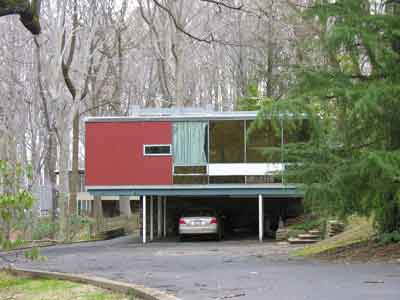International
True examples of the International Style are rather rare and mostly date from the 1930s, not the postwar period. Most International style houses are architect designed and follow the theory of early proponent, French architect Le Corbusier, that houses should be “machines for living.” As functional machines, houses thus should be free from decorative details which do not contribute to their efficiency. This theory of form following function (as first expressed by Louis Sullivan, America’s first modern architect, in 1896) affected other house designs of the mid 20th century, even those which did not reject all ornamentation and traditional forms. A new interest in the International Style occurred in the 1970s by a group of New York architects, but the style remains rare in domestic architecture.
Identifiable Features
- Flat roof, sometimes with cantilevered sections
- Metal casement windows set flush with outer walls
- No decorative details at windows and doors
- Asymmetrical facade
- Smooth, unornamented exterior surface
- Recessed entry
Photos
Click any image to enlarge.
